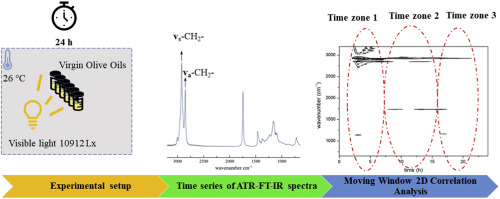Our official English website, www.x-mol.net, welcomes your
feedback! (Note: you will need to create a separate account there.)
Getting inside on virgin olive oil (VOO) photooxidation kinetics through combined generalized 2D correlation analysis and moving window 2D correlation analysis of ATR-FTIR spectra.
Talanta ( IF 5.6 ) Pub Date : 2020-03-14 , DOI: 10.1016/j.talanta.2020.120917 Anthia Matsakidou 1 , Despina Papadopoulou 1 , Nikolaos Nenadis 1 , Maria Z Tsimidou 1
Talanta ( IF 5.6 ) Pub Date : 2020-03-14 , DOI: 10.1016/j.talanta.2020.120917 Anthia Matsakidou 1 , Despina Papadopoulou 1 , Nikolaos Nenadis 1 , Maria Z Tsimidou 1
Affiliation

|
The generalized two-dimensional correlation spectroscopy (g2D-COR spectroscopy) analysis combined with its extended version moving-window 2D-COR (MW-2D-COR) was performed on a set of kinetic ATR-FTIR spectral data. The former is a mathematical method that is applied to a set of spectra collected for a sample exposed to an external perturbation (e.g. storage time). Virgin olive oils (VOOs) of similar fatty acid composition, chlorophyll, and a-tocopherol content were photooxidized (10,912 Lx, no headspace, 24 h). The proposed approach revealed hidden information under specific ATR-FTIR bands and the order of events was established using appropriate rules. MW-2D-COR analysis displayed the evolution of changes during storage. In this way, the detection of the time interval upon which spectral changes are observed was evidenced. As an overview, MW plots of the analyzed samples revealed three time-zones in which changes tend to maximize, with the first one to reach a peak at ~2.5 h. The area around 2850-2930 cm-1 including bands assigned to the symmetric and asymmetric stretching vibration of the aliphatic -CH2- bonds, was the one found to be affected in all VOOs. The time interval upon which spectral changes are first detected in the corresponding area could serve as an index for the commencement of the loss of freshness. Present findings highlight the need to combine the two types of correlation analyses to obtain meaningful information on VOO photooxidation kinetics. Lipid scientists may gain an extra tool in their efforts to understand oxidation phenomena.
中文翻译:

通过结合广义2D相关性分析和ATR-FTIR光谱的移动窗口2D相关性分析,深入了解原始橄榄油(VOO)的光氧化动力学。
在一组动态ATR-FTIR光谱数据上进行了广义二维相关光谱(g2D-COR光谱)分析及其扩展版本的移动窗口2D-COR(MW-2D-COR)分析。前者是一种数学方法,适用于为暴露于外部扰动(例如存储时间)的样本收集的一组光谱。脂肪酸组成,叶绿素和α-生育酚含量相似的初榨橄榄油(VOOs)被光氧化(10,912 Lx,无顶空,24 h)。拟议的方法揭示了特定ATR-FTIR频段下的隐藏信息,并使用适当的规则确定了事件的顺序。MW-2D-COR分析显示了存储过程中变化的演变。以这种方式,证明检测到观察到光谱变化的时间间隔。作为概述,所分析样品的MW图显示了三个时区,其中变化趋于最大化,第一个时区在〜2.5 h达到峰值。发现2850-2930 cm-1附近的区域(包括分配给脂肪族-CH2-键的对称和不对称拉伸振动的带)在所有VOO中都受到影响。在相应区域中首先检测到光谱变化的时间间隔可以用作开始新鲜度降低的指标。目前的发现强调需要结合两种类型的相关性分析以获得关于VOO光氧化动力学的有意义的信息。脂质科学家在了解氧化现象的努力中可能会获得额外的工具。发现2850-2930 cm-1附近的区域(包括分配给脂肪族-CH2-键的对称和不对称拉伸振动的带)在所有VOO中都受到影响。在相应区域中首先检测到光谱变化的时间间隔可以用作开始新鲜度降低的指标。目前的发现强调需要结合两种类型的相关性分析以获得关于VOO光氧化动力学的有意义的信息。脂质科学家在了解氧化现象的努力中可能会获得额外的工具。发现2850-2930 cm-1附近的区域(包括分配给脂肪族-CH2-键的对称和不对称拉伸振动的带)在所有VOO中都受到影响。在相应区域中首先检测到光谱变化的时间间隔可以用作开始新鲜度降低的指标。目前的发现强调需要结合两种类型的相关性分析以获得有关VOO光氧化动力学的有意义的信息。脂质科学家在了解氧化现象的过程中可能会获得额外的工具。在相应区域中首先检测到光谱变化的时间间隔可以用作开始新鲜度降低的指标。目前的发现强调需要结合两种类型的相关性分析以获得有关VOO光氧化动力学的有意义的信息。脂质科学家在了解氧化现象的过程中可能会获得额外的工具。在相应区域中首先检测到光谱变化的时间间隔可以用作开始新鲜度降低的指标。目前的发现强调需要结合两种类型的相关性分析以获得有关VOO光氧化动力学的有意义的信息。脂质科学家在了解氧化现象的过程中可能会获得额外的工具。
更新日期:2020-03-16
中文翻译:

通过结合广义2D相关性分析和ATR-FTIR光谱的移动窗口2D相关性分析,深入了解原始橄榄油(VOO)的光氧化动力学。
在一组动态ATR-FTIR光谱数据上进行了广义二维相关光谱(g2D-COR光谱)分析及其扩展版本的移动窗口2D-COR(MW-2D-COR)分析。前者是一种数学方法,适用于为暴露于外部扰动(例如存储时间)的样本收集的一组光谱。脂肪酸组成,叶绿素和α-生育酚含量相似的初榨橄榄油(VOOs)被光氧化(10,912 Lx,无顶空,24 h)。拟议的方法揭示了特定ATR-FTIR频段下的隐藏信息,并使用适当的规则确定了事件的顺序。MW-2D-COR分析显示了存储过程中变化的演变。以这种方式,证明检测到观察到光谱变化的时间间隔。作为概述,所分析样品的MW图显示了三个时区,其中变化趋于最大化,第一个时区在〜2.5 h达到峰值。发现2850-2930 cm-1附近的区域(包括分配给脂肪族-CH2-键的对称和不对称拉伸振动的带)在所有VOO中都受到影响。在相应区域中首先检测到光谱变化的时间间隔可以用作开始新鲜度降低的指标。目前的发现强调需要结合两种类型的相关性分析以获得关于VOO光氧化动力学的有意义的信息。脂质科学家在了解氧化现象的努力中可能会获得额外的工具。发现2850-2930 cm-1附近的区域(包括分配给脂肪族-CH2-键的对称和不对称拉伸振动的带)在所有VOO中都受到影响。在相应区域中首先检测到光谱变化的时间间隔可以用作开始新鲜度降低的指标。目前的发现强调需要结合两种类型的相关性分析以获得关于VOO光氧化动力学的有意义的信息。脂质科学家在了解氧化现象的努力中可能会获得额外的工具。发现2850-2930 cm-1附近的区域(包括分配给脂肪族-CH2-键的对称和不对称拉伸振动的带)在所有VOO中都受到影响。在相应区域中首先检测到光谱变化的时间间隔可以用作开始新鲜度降低的指标。目前的发现强调需要结合两种类型的相关性分析以获得有关VOO光氧化动力学的有意义的信息。脂质科学家在了解氧化现象的过程中可能会获得额外的工具。在相应区域中首先检测到光谱变化的时间间隔可以用作开始新鲜度降低的指标。目前的发现强调需要结合两种类型的相关性分析以获得有关VOO光氧化动力学的有意义的信息。脂质科学家在了解氧化现象的过程中可能会获得额外的工具。在相应区域中首先检测到光谱变化的时间间隔可以用作开始新鲜度降低的指标。目前的发现强调需要结合两种类型的相关性分析以获得有关VOO光氧化动力学的有意义的信息。脂质科学家在了解氧化现象的过程中可能会获得额外的工具。











































 京公网安备 11010802027423号
京公网安备 11010802027423号